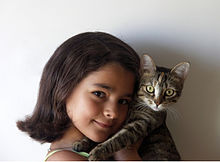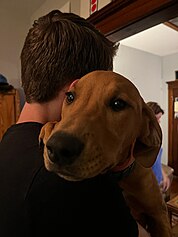|
Pet humanization
 Pet humanization is the practice in pet culture of treating companion animals with a level of care, attention, and luxury relatively higher than for the average domesticated animal. This trend involves the owners being at odds with the pet's status as property in wider society and can range from relying on them for emotional support to treating them like human family members.[1][2] To the extent that the treatment involves providing for the pet beyond their means of appreciation, it is considered to be a form of anthropomorphism though the limits of this remain an open topic. History In many ancient civilizations, people formed close bonds with animals, often using them for various purposes like hunting, protection, companionship, and animal worship. For example, some cats in ancient Egypt were considered sacred animals and were personified with the deity Bastet,[3] and provided with elaborate burials.[4] Dogs in religion hold various symbolic and cultural meanings across different religions and belief systems. The modern concept of pet humanization began to gain significant momentum in Western culture and societies during the 19th century and continued to grow throughout the 20th century, along with the present day. In the mid-20th century, the pet industry started to expand, offering a wide range of products and services which cater to pet owners' desires to provide the best possible care for their animals. This included the development of specialized pet foods,[5] veterinary medicine, grooming services, and even luxury items.[6] In the modern era, this trend reflects changing societal attitudes towards pets, where they are seen less as a property and more as valued members of the family.[7] Key aspectsKey aspects of pet humanization include owners that may prioritize premium or organic pet food, special diets, and even preparing homemade meals for their pets.[8] Pets receive regular check-ups, vaccinations and even medical treatments that were once uncommon. Pets may have a wide array of accessories such as clothing, collars, leashes, and even designer items. Luxurious pet accommodations, such as elaborate pet beds or specialized animal furniture, may be used. Pets are provided with toys, entertainment and enrichment activities to keep them mentally stimulated. Pets might have birthdays celebrated with parties, special treats, and social gatherings. Pet-friendly accommodations and travel arrangements are made for vacations or trips. There are times when pets have their own social media profiles with followers and interactions. Owners often form deep emotional bonds with their pets, considering them as family members and seeking companionship and emotional support from them. Human psychology The psychology behind pet humanization involves understanding the motivations, emotions and behaviours that drive individuals to treat their pets as more than just animals and instead as valued members of the family or even as surrogate companions.[9] Humans have a natural inclination to form emotional bonds with other living beings, and pets often provide unconditional love, companionship, and a sense of belonging. This emotional connection can lead to the desire to provide the best possible care and attention to pets.[10] AnthrozoologyAnthrozoology is the interdisciplinary study of the interactions and relationships between humans and animals. It encompasses a wide range of topics related to human-animal interactions, including the emotional, psychological, social, and biological aspects of these relationships.[11] Pet humanization is a concept within the field of anthrozoology that focuses on the tendency of humans to attribute human-like qualities and behaviours to their pets. Pet food industry Pet humanization has a significant impact on the pet food industry, leading to changes in consumer preferences, product offerings, and marketing strategies.[12] As pet owners increasingly view their pets as integral members of their families, they seek out higher quality and more specialized food options for their pet companions.[13] Pet owners who humanize their pets often seek pet foods made with high-quality, natural, and wholesome ingredients.[14] This has led to a rise in demand for premium pet foods that are free from artificial additives, preservatives and fillers. Pet healthcarePet healthcare and pet humanization has had a notable impact on the health care of pets, leading to changes in how pet owners approach veterinary care, preventive measures, medical treatments, and overall wellness for their animal companions.[15]  Pet insurance is considered a component of pet humanization because it reflects the growing trend of treating pets as members of the family and providing them with similar care and services that humans receive.[16] Pet bereavementPet bereavement and pet humanization are two concepts that are closely related and often intersect in the realm of human-pet relationships.[17][18][19] Pet bereavement is the emotional response that pet owners experience when their pets pass away. It involves a range of emotions similar to the mourning process for a human loved one.[20][21][22][23] See also
Further reading
References
External linksLook up pet humanization in Wiktionary, the free dictionary. |